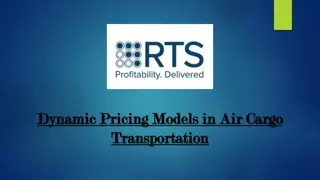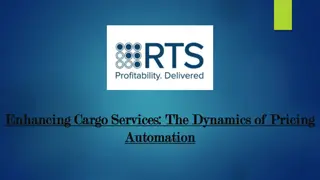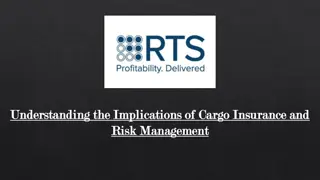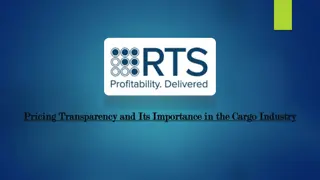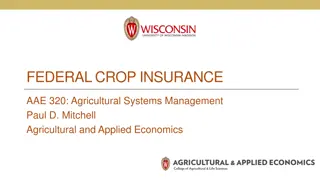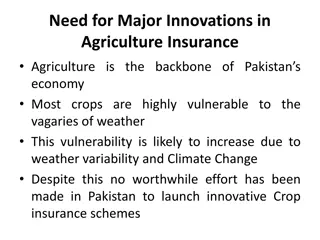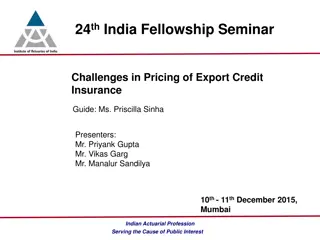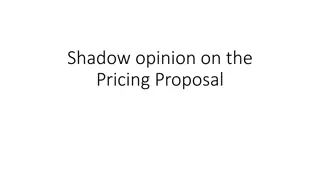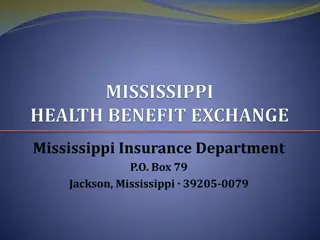Crop Insurance Pricing Webinar with A.V. Karthikeyan - June 26, 2020
Join the webinar on June 26, 2020, focusing on Crop Insurance Pricing featuring A.V. Karthikeyan, the Appointed Actuary at Reliance General Insurance. Explore topics such as risk assessment, pricing dynamics, and the role of actuaries in the crop insurance industry. Gain insights into the importance of understanding agronomy and plant physiology for pricing actuaries. Enhance your knowledge and skills in the field of crop insurance through engaging discussions and expert insights.
Download Presentation

Please find below an Image/Link to download the presentation.
The content on the website is provided AS IS for your information and personal use only. It may not be sold, licensed, or shared on other websites without obtaining consent from the author.If you encounter any issues during the download, it is possible that the publisher has removed the file from their server.
You are allowed to download the files provided on this website for personal or commercial use, subject to the condition that they are used lawfully. All files are the property of their respective owners.
The content on the website is provided AS IS for your information and personal use only. It may not be sold, licensed, or shared on other websites without obtaining consent from the author.
E N D
Presentation Transcript
Webinar on June 26, 2020 Time 1600 to 1730 IST Crop Insurance Pricing A V Karthikeyan Appointed Actuary Reliance General Insurance The Institute of Actuaries of India
Welcome Instructions Mute Q&A IAI support CPD Recording Feedback www.actuariesindia.org
Setting the tone 1. INR 30k cr or USD 4b annual premiums. 2. Tool for smoothing consumption and continuing food security. 3. Substantially reinsured portfolio. 4. Pricing but not reserving-intensive, due to short-tail nature. 5. More pricing dynamics need greater investment in underwriter s modelling skills. www.actuariesindia.org
Introductory comments Sunil Sharma President, Institute of Actuaries of India www.actuariesindia.org
Speakers profile A V Karthikeyan Appointed Actuary, Reliance General Insurance A V Karthikeyan is the Appointed Actuary of Reliance General Insurance. He has more than 15 years work experience in the Indian General Insurance industry with significant work exposure in underwriting, product designing and actuarial functions. Karthikeyan is a FIAI and a CERA. Before the actuarial qualifications, he holds a MBA and a Bachelors in Agricultural Sciences [BSc (Agriculture)]. www.actuariesindia.org
Key questions 1. Would it be necessary for a pricing actuary to understand agronomy (including plant physiology) and phenology as compared with the present practice of determining crop insurance premium rates from burning cost? 2. Would risk assessment become superior if the pricing approach changes as above? www.actuariesindia.org
Poll Question 1 Which parameters are currently modelled by crop insurers? A. Weather only B. Crop Yield only C. Both D. Both + one-off events like locust swarm, Covid-19, etc. www.actuariesindia.org
Poll Question 2 How important is it for the pricing actuary to know plant physiology (during germination, standing time, harvesting) while pricing insurance risks? A. Not important B. Somewhat important C. Important D. Very important. www.actuariesindia.org
Poll Question 3 Please match the type (linear, ordinal, categorical) of independent variable with the associated risks. X. Linear Y. Ordinal Z. Categorical i. ii. Locust swarm iii. No. of continuous days of hail Rainfall A. X-i, Y-iii, Z-ii B. X-ii, Y-i, Z-iii C. X-iii, Y-ii, Z-i D. X-iii, Y-ii, Z-i www.actuariesindia.org
PMFBY - Introduction Pre Sowing / Germination Stage 1. Prevented Sowing due to adverse weather 2. If > 75% of the notified area remain unsown then 25% of the SI is payable. Policy terminates. Post Harvest Stage 1. Weather related impact on crops lying in the filed post harvest up to 14 days (cut and spread / small bundles) 2. Excess Rainfall > 20% over long term average is the primary trigger. Standing Crops Stage 1. Area Approach i.e. Yield shortfall measured using CCEs at Insurance Unit level 2. Claims settled based on the below formula (calculated at IU level): Claims = (TY AY) / TY * SI 3. SI determined by Scale of Finance Other Key Features: Compulsory for Loan Farmers. Optional for non-loan farmers Premium rates are not capped. But farmer shares are capped. Key stakeholders: Farmer, Central Government, State Government, Insurer (and Reinsurers) and Financial Institutions Other Covers are Localised Losses (hailstorm, landslide, inundation, cloud burst and natural fire due to lighting) and On Account Payment due to Mid Season Adversity (if , due to adverse weather events the yield is expected to less than 50% of Normal Yield. Claim Payable is 25% of the expected claims) 10
PMFBY - Introduction Clusters (as per operational guidelines): Cluster 1 1. Must contain high risk and low risk districts Districts of different agro climatic zones ESI for each cluster must be similar May be left unchanged for 3 years 2. 3. 4. District 1 (CCE = 24) District 2 Taluk/ Tehsil Block1 (CCE = 16) Block2 Block n Mandal / Revenue Circle/Firka/Hobli (CCE sample = 10) GP (CCE Sample = 4) 11
PMFBY a Risk Perspective Pre Production Production Post- Production Biological Risks / Weather Risks Poor Quality Inputs like Seeds, Fertilizers and Manures Water Availability Impact of Previous Crop Pests, Weeds, Pollinators activity Diseases, Wind Parameters Irrigation inputs like fertilizers etc Weather parameters like temperature, wind etc, Pest Result: Lower Area Sown, Failed Germination, Lower Yield , Poorer quality of produce (?) Result: Mid Season Failure, Lower Yield, Requirement of more inputs like more irrigation or pesticide pushing up cost (?), Effect on the next crop( ?), Poorer Quality (?) Result: Loss of produce in the field, Loss of produce post transportation, Storage or in processing (?), Processing cost increase (?) Quality degradation (?) Credit Risks/ Market Risks Cost of inputs is inflation prone, Access to institutional credits Similar to pre production phase Lower realisation for the produce, inadequate post production processes Results: Higher Cost of Inputs (higher scale of finance but with a lag), less than required inputs resulting in crop failure Results: Higher Cost of Inputs (higher scale of finance but with a lag), less than required inputs resulting in crop failure Results: Financial Losses (?) and impact on the next season (?) and cost escalations (?) Human / Personal Risks Personal Risks like Accident sickness etc / Systemic risk like non availability of labour, Skills and Knowledge Result: Adverse Yield (personal losses are not covered, systemic losses do get covered in the form of lower yield), Adoption of mechanisation Same like pre production + new technologies and ability to use knowledge based inputs Delay in post harvest production / wrong post harvest production Result: Adverse Yield (personal losses are not covered, systemic losses do get covered in the form of lower yield), increased costs (?) IAI webinar on Pricing Crop Insurance Result: Longer exposure time in the fields especially due to seasonal labour non availability Can result in poor quality output (?) 26th June 2020 12
PMFBY as a part of Risk Management Risk Transfers and Risk Retained Credit and Market Support PMFBY / RWBCIS Other Social Insurance Schemes like Health, PA, Life and Assets Agricultural Loan and Land Development Loans Institutional Infrastructure and Policy Support Effective Institutitions to administer, support and manage schemes with overseeing mechanisms Input Credits and other subsidies Infrastructure development Agricultural Extensions & Advisory, Weather and Agro Forecasting and Irrigation development Budgetary Allocation for Various Risk Alleviation Mechanisms Relief Schemes and Disaster Funds Procurement Support like MSPs 26th June 2020 IAI webinar on Pricing Crop Insurance 13
Pricing Policy Determinants 1. RI capacity in place vs budgets (if deviated, reasons) 2. Net Protection arrangements 3. RI panel and credit rating 4. Past treaty performances and balances 5. Loss sharing clauses, Single state clauses 1. State to State implementation machinery Variations 2. Past Loss Experience 3. Agro infrastructure development e.g. Any investment in dams / irrigation, water levels in Dams especially for downstream riparian states Reinsurance arrangements in place and aspects like RI commission and past treaty performances State Selection any scheme choices exhibited by the state, level of disputes etc Company strategy, capabilities and past performances Scheme Nature, Covers and SI changes Competition strategy and capacity supply 1. Past Performance 2. Balance sheet and solvency strength 3. Basis for budgeting 4. Reserving approaches and adequacy 5. Investment of the Company in strengthening UW, Sales and Claims 6. Process controls - CCE approaches, outsourcing vs in-house, reconciliations, dispute handling approaches 26th June 2020 Scheme rules can change with respect to: 1. Indemnity Level 2. Crops covered 3. Tenure 4. Scale of Finance 5. Revamped Scheme from Kharif 2020 -21 1. 2. 3. 4. Past results Solvency position RI terms and capacity Team changes IAI webinar on Pricing Crop Insurance 14
New Changes in PMFBY (2020-21 onwards) Trends in tenders released until 15 th June 2020 Scheme Options Until 2019-20 Preferable: 3 Yrs Min: 1 year Kharif 2020-21 Tenure Min: 3 Year No Deviations Compulsory for Loanee Voluntary for Non Loanee farmers The cover is optional for all farmers. Selection Options No Deviations Basic: Standing Crop Optional: Prevented Sowing, Post Harvest Losses, Localised Calamities States can also take single peril covers like hailstorm Basic: Prevented Sowing + Standing Crop + Post Harvest Losses + Localised Calamities Optional: Crop Loss due to Wild Animals Attack Most states has taken the Basic (until 2019- 20) covers and has not unbundled the covers Covers Fixed TY Laddered TY Variable TY Except for 1 state, so far all other states has opted Fixed TY TY Calculations Fixed TY 26th June 2020 IAI webinar on Pricing Crop Insurance 15
New Changes in PMFBY (2020-21 onwards) Trends in tenders released until 15 th June 2020 Scheme Options Until 2019-20 Kharif 2020-21 Subsidy will be still equally shared up to a cap on the premium rate. The cap is 30% for unirrigated areas/crops and 25% for irrigated areas/ crops. Apart from Farmer's Share, the rest is equally shared by the state and the central NE Indian states alone are eligible up to 90% central subsidy Central Govt Subsidy Smart Sampling (Strateified Sampling) to optimise CCEsAllowed (States can...) Two step process of Loss Estimation to be adopted based on "Deviation Matrix" using specific triggers like weather indicators, satellite imagery etc for targeting CCE In case of non provision of yield data beyond cut off date, the Insurer can settle claims using yield estimated by technology solutions 26th June 2020 No deviations Directed (States have to...) Adoption to be seen Not mentioned Newly intorduced Detailed guidelines awaited IAI webinar on Pricing Crop 16 Not mentioned Newly introduced Insurance Detailed guidelines awaited
State is the most important selection Cluster and Data level Definitions Crops included in the scheme Type of Scheme Yield data level vs IU definitions Clusters definitions New crops Clarity on yield calculations e.g. Number of pickings, with / without pods etc. PMFBY/RWBCIS State Schemes TY calculations Indemnity Levels SI basis Options now available Fixed TY/ Laddered TY/ Variable TY 70%, 80%, 90% Can become complex in case of new district / crop Scale of Finance NAY*MSP or Farm gate price Perils Covered CCE Mechanisms Dispute Mechanisms Prevented Sowing Localised Calamity Mid Season Adversity Post Harvest losses Single Peril losses Departments involved in CCE Optimisation Two Step Process for CCE estimation Appeal Mechanisms Litigation Nature and Past Trends 26th June 2020 IAI webinar on Pricing Crop Insurance 17
Pricing Component of PMFBY Heterogeneity Loading + CAT Loadings Historical Burn Cost + Add on Covers Commercial Premiums Administrative Costs + Capital Costs Long Term Consideration Tactical Consideration 26th June 2020 IAI webinar on Pricing Crop Insurance 18
Steps in Burn Cost calculation 1. Yield data by crop, IU for 7 years or more 2. Insured Area for the past years 3. Sowing Areas for the past year 4. Past premiums and Claims 5. Sum Insured in the past and proposed 6. Rainfall and other key weather parameters Cluster Selection + Seasonal Forecast Yield Data - Collection and Validation Threshold Yield (TY) Calculation Yield De-trending Historical Burn Cost 1. Total ESI and its fitment with overall business objectives 2. Past Experience of the Cluster 3. Main Crop Mix and Irrigated : Rain-fed mix 4. Past rainfall patterns 5. Company s preparedness 6. Present forecasts like El Nino and IOD 7. Past sources of disputes and how are they addressed at present (like localised calamities and CCEs ) Three options of TY: 1. Fixed TY 2. Laddered TY 3. Variable TY 26th June 2020 IAI webinar on Pricing Crop Insurance 19
Understanding Various TYs Year 2013 2014 2015 2016 2017 2018 2019 Yields 1000 1000 1600 1900 1850 1400 1200 Indemnity Level : 70% 1. Fixed TY = (Average of Best 5 Years) * 70% = 1113 2. Laddered TY: Laddered TY for Year 1 = Fixed TY = 1113 Laddered TY for Year 2 = Fixed TY * (1+ Average Yield Growth Rate in latest 7 years) = 1113 * { 1 + [ (1000/1000-1) + (1600/1000-1).....+(1200/1400-1)]} = 1113 * {1+0.0625} = 1183 Laddered TY for Year 3 = 1183 * {1+0.0625} = 1257 3. Variable TY: Variable TY for Year 1 = Fixed TY = 1113 Variable TY for Year 2 = recalculate TY including yield data of Year 1 Variable TY for Year 3 = recalculate TY including yield data of Year 1 & Year 2 26th June 2020 IAI webinar on Pricing Crop Insurance 20
De-Trending Yield Data De-trending: A trend is a change in the mean over time in the observations of a time series. De-trending is a statistical process that aims to remove the effect of this change and re-state the observations on par , so that the de-trended data is useful for further modelling / predictions. In Crop Insurance, we typically use linear de-trending techniques. The following formula could be set up easily in typical spreadsheet applications like MS excel: Slope * (Latest Year Observation Year) + Actual Data for the Observation Year 1. 2. 3. 4. When do we de-trend Which Statistic to depend upon How much of the Trend to allow for At what granularity level trending to be done 26th June 2020 IAI webinar on Pricing Crop Insurance 21
De-trending the Data case of Bt Cotton in Gujarat Case of Gujarat Cotton Crop Rainfed Cotton Yield (Kg/Ha of Lint) Irrigated Cotton Yield (Kg/Ha of Lint) Cotton Yield (Kg/Ha of Lint) 265 Rainfed Area in Lakhs Ha Proportio n of Irrigated Areas Irrigated Area in Lakhs Ha Area in Lakhs Ha 14 Year 1996 140 9 504 5 34% Period of negative Growth 304 14 1997 175 9 534 5 36% 356 15 1998 232 10 575 5 36% 400 16 1999 264 11 635 6 36% 230 15 2000 136 9 378 6 39% 122 16 2001 63 11 233 6 35% 165 17 2002 99 11 268 7 39% 175 16 2003 102 10 285 7 40% 417 16 Period of Positive Growth 2004 219 10 703 7 41% 494 19 2005 265 11 783 8 44% 581 20 2006 311 11 883 9 47% 564 23 2007 257 10 776 14 59% 581 24 2008 282 9 770 15 61% 507 23 2009 247 10 683 14 60% 511 24 2010 198 7 527 19 77% 637 26 2011 308 6 738 20 77% 587 30 2012 271 9 726 21 69% 343 24 2013 147 9 463 15 62% IAI webinar on Pricing Crop Insurance 694 19 685 26 2014 388 8 827 18 68% Yield Plateau 544 28 2015 265 10 65%
Poll Question 4 When is de-trending NOT NECESSARY in the situations below? A. The district in the past 5 years has started adopting some new seeds variety that will increase the drought resistance of the crops The district has been affected by wide spread hailstorm in the past and has been fortunately not affected in past 3 years Over pumping of ground water has reduced water table in the district and increased salinity due to sea water influx. This has started reducing yields in the last 5 years. B. C. 26th June 2020 IAI webinar on Pricing Crop Insurance 23
De-trending P vale vs RSQ Gujarat Cotton data from 2002 to 2008 - De-Trending Gujarat Cotton data from 2008 to 2015 - De-trending 800 800 700 600 600 500 400 400 Slope = 78.214 R = 0.8441 300 200 P value based on T test = 0.0012 Slope = 5.8929 R = 0.0133 P Value = 0.8028 200 100 0 2002 2003 Actual Data 2004 2005 2006 De-Trended Data 2007 2008 0 2009 2010 2011 2012 2013 2014 2015 2 alternative criterions used: a. F Test with P Value < 5% Gujarat Cotton data from 2002 to 2015 - De-Trending 1000 800 Excel Formula for the T Statistic: Slope (of observations) / Index (Linest ( observations range, Observation Year range, , True),2) .... Basically slope / SSEs 600 400 Slope= 23.229 R = 0.3763 P Value = 0.0176 200 P Value = TDIST (T Statistic , Number of Years (i.e. Degree of freedom), 2 (i.e. Two tailed) 0 2002 2003 2004 2005 2006 2007 2008 2009 2010 2011 2012 2013 2014 2015 b. Simple Linear Trending with Coefficient of Determination > 70% Actual Data De-Trended Data c. How much of calculated trend is to be allowed... Do we want to remove all randomness? 24
Heterogeneity in Yield Data Causes: 1. The granularity level of data used for pricing and for settling claims are different. The pricing data is at higher level of granularity (e.g. Block / district) and the claims is settled at a lower level of hierarchy (e.g. Gram Panchayat) Sometimes, data for pricing is only partially available at the lowest level of hierarchy (like it is available for 3 - 4 years only) 2. As the lower levels of granularity lacks statistical credibility, it can bring about more volatility in the experience and can increase the pricing risks. Alternative approaches to arrive at heterogeneity loadings: 1. A standard pricing matrix based on GIC Re s recommended pricing methodology 2. Simulation based method reference: presentation made by Mr. Shashank Kaushik at the IAI s Capacity Building Seminar in Crop Insurance on 26hSeptember 2019 3. Credibility based method reference: WPS5986, World Bank, Daniel J Clarke, Oliver Mahul and Niraj Verma 25
Heterogeneity loading a. b. Heterogeneity should be calculated for each year of data per district per crop separately. For the year under consideration, only distinct values should be considered to find the level of data. Classification of various level is hereunder: Level 1 - District Level Level 2 - Tehsil or equivalent level Level 3 - Block or equivalent level Level 4 - Gram panchayat or equivalent level. The heterogeneity loadings for a District-Crop for a particular year under consideration, should be as per the below matrix: c. Implementation Unit (IU) Level 2 15% 0% 0% Particulars Level 1 0% 0% 0% Level 3 20% 15% 0% Level 4 30% 20% 15% Level 1 Level 2 Level 3 Data Availability of Pricing Level 4 0% 0% 0% 0% d. Final Heterogeneity load will be the simple average of heterogeneity values calculated for each year per district per crop. e. Pure Premium after heterogeneity loading = Pure Premium * (1+ average calculated above in step d) 26
Simulation Methodology for removing Heterogeneity 1 . Identify years in which data at GP level and at higher level (say block) Area Y1 Y2 Y3 Y4 Y5 Y6 Y7 Y8 Y9 Y10 TY GP1 GP2 GP3 GP4 GP5 GP6 GP7 Block level 0.1 0.13 0.06 0.07 0.33 0.2 0.11 2,085 2,085 2,085 2,085 2,085 2,085 2,085 2,085 2,338 2,338 2,338 2,338 2,338 2,338 2,338 2,338 1,981 1,981 1,981 1,981 1,981 1,981 1,981 1,981 1,950 1,950 1,950 1,950 1,950 1,950 1,950 1,950 2,603 2,603 2,603 2,603 2,603 2,603 2,603 2,603 2,259 2,259 2,259 2,259 2,259 2,259 2,259 2,259 2,550 2,372 2,614 1,499 1,706 2,677 2,550 2,204 2,208 2,063 1,981 2,208 1,956 2,634 1,989 2,153 2,258 3,350 2,997 2,219 2,288 2,546 1,484 2,424 1,401 1,592 1,413 1,369 1,303 2,196 1,338 1,544 2,057 2,143 2,122 1,985 1,964 2,175 1,997 2 . For the GP years, calculate the ratio of the GP level yield to that of the block and using these ratios, calculate the Average and Standard Deviations for each GP Ratio of GP to Block Ratio Mean Ratio SD Y7 Y8 Y9 Y10 GP1 GP2 GP3 GP4 GP5 GP6 GP7 1.16 1.08 1.19 0.68 0.77 1.21 1.16 1.03 0.96 0.92 1.03 0.91 1.22 0.92 0.93 1.38 1.24 0.92 0.94 1.05 0.61 0.91 1.03 0.92 0.89 0.84 1.42 0.87 1.005 1.112 1.065 0.877 0.868 1.228 0.890 0.113 0.187 0.171 0.144 0.075 0.152 0.224 27
3 . Using the above Mean and SDs, simulate 100 GP values using normal distribution assumptions. If the year is a GP year, duplicate the yield value 100 times, otherwise multiply the simulated value with Block Level yields. Using the above simulated values, calculate the burn costs at each GP level and take an average at each GP level (outliers are to be excluded, say at p2 and p98 of the ratios). BurnCost based on Actual Data Y6 0% 0% 0% 0% 0% 0% 0% 0% 0% 0% 0% 0% 0% 0% Y1 Y2 Y3 Y4 Y5 Y7 Y8 Y9 Y10 Overall (average) GP1 GP2 GP3 GP4 GP5 GP6 GP7 0% 3% 2% 0% 0% 4% 0% 0% 0% 0% 0% 0% 0% 0% 4% 8% 7% 0% 0% 9% 1% 5% 9% 8% 2% 1% 10% 2% 0% 0% 0% 24% 13% 0% 0% 0% 4% 7% 0% 0% 0% 0% 0% 0% 0% 0% 0% 0% 26% 32% 26% 33% 31% 34% 0% 33% 4% 5% 6% 6% 5% 2% 6% BurnCost based on Simualted Data Y5 Y6 0% 1% 0% 1% 0% 1% 3% 5% 0% 4% 0% 0% 6% 13% Y1 Y2 Y3 Y4 Y7 Y8 Y9 Y10 Overall (average) GP1 GP2 GP3 GP4 GP5 GP6 GP7 3% 3% 4% 10% 8% 1% 15% 0% 1% 2% 4% 2% 0% 13% 6% 4% 6% 13% 12% 1% 19% 7% 6% 6% 14% 13% 1% 21% 0% 0% 0% 24% 13% 0% 0% 0% 4% 7% 0% 0% 0% 0% 0% 0% 0% 0% 0% 0% 26% 32% 26% 33% 31% 34% 0% 33% 5% 5% 6% 10% 9% 0% 15% Y1 Y2 Y3 Y4 Y5 Y6 Y7 Y8 Y9 Y10 Overall (average) Block level with Heterogenity Load Block level without Heterogenity Load 6% 3% 9% 10% 1% 3% 6% 1% 3% 25% 7% 26th June 2020 IAI webinar on Pricing Crop Insurance 28 1% 0% 4% 5% 0% 0% 6% 1% 3% 25% 5%
Poll Question 5 Which of following is NOT preferred in heterogeneity loading? It should not be sensitive to the number of years in which historical yield data is in different level of granularity It should be sensitive to the number of years in which historical yield data is in different level of granularity It should be sensitive to volatility of yields between IUs A. B. C. 26th June 2020 IAI webinar on Pricing Crop Insurance 29
Credibility Theory based method for removing heterogeneity A heterogeneity loading must have these qualities: i. Loading to be higher, if more number of years are having higher level of hierarchy (say district) Loading to be higher, if the district is exhibiting agronomical heterogeneity Loading to be higher, if the districts is getting broken in more and more smaller IU s (because the volatility of the results changes) Loading to be higher, if the volatility within a block / GP (i.e. Lower level of hierarchy) is higher ii. iii. iv. Empirical Bayesian Credibility Factor can address these requirements 30
Credibility Theory based method for removing heterogeneity (2) Y1 Y2 Y3 Y4 Y5 Y6 Y7 Y8 Y9 Y10 Mean Variance GP1 2,776 2,669 2,335 2,053 1,724 1,755 2,550 2,208 2,258 1,401 2,173 1,96,949 GP2 2,666 2,560 2,032 1,040 2,107 2,525 2,372 2,063 3,350 1,592 2,230 3,96,164 GP3 2,295 2,397 1,581 1,599 1,904 1,794 2,614 1,981 2,997 1,413 2,057 2,57,400 GP4 2,047 2,734 2,437 1,220 2,460 1,845 1,499 2,208 2,219 1,369 2,004 2,57,292 GP5 1,678 2,167 1,735 1,862 2,885 2,518 1,706 1,956 2,288 1,303 2,010 2,14,107 GP6 2,087 2,182 2,321 1,886 3,017 2,363 2,677 2,634 2,546 2,196 2,391 1,10,137 GP7 1,892 2,294 1,645 1,194 2,860 1,954 2,550 1,989 1,484 1,338 1,920 2,112 26,264 2,84,419 2,45,210 Means Sample Variance Less volatility within each GP Agronomically more hetergenous Base Scenario Scenarios Note: Heterogeneity Loading = 1 + (A+B*Z)*(7 number of years at GP level) N (Number of GPs) 7 7 7 n (Number of Years) 10 10 10 X (Average of sample means) 2,112 2,112 2,112 A & B are constants that can be chosen by the Actuary VAR (Sample Variance) 26,264 50,000 26,264 E[S^2 (?)] 2,45,210 2,45,210 1,96,168 Var [m(?))] i.e. Max (VAR - E[S^2 (?)]/n , 0) 1,743 25,479 6,647 K i.e. E[S^2 (?)] / Var [m(?))] Z i.e. n/(n+K) 141 10 30 6.64% 50.96% 25.31% 31
Poll Question 6 In your opinion, which loss is MOST COMMONLY captured in the historical yield data? A. B. C. D. Standing Crop Losses Prevented Sowing Post Harvest Losses Localised calamities 26th June 2020 IAI webinar on Pricing Crop Insurance 32
Losses not captured by Yield data 1. Post Harvest Losses: i. Eligibility: These claims are payable on individual plot basis in case of unseasonal Hailstorm, Cyclone etc... Damaging harvested crop lying in the field in Cut and Spread Condition or Small Bundled Condition up to 2 weeks since harvest. Trigger: 20% excess Rainfall over and above LTA for the district ii. Important to understand post harvest practices for crops. In general, on field mechanical harvesting (such as using of combined harvester) reduces need for cut and spread conditions . Legume crops like Soybean, Green Gram, Tur Dal etc, needs to be harvested slightly ahead of complete drying of pods, these crops needs to dried for a few days before threshing. Groundnut also need to pulled out and cured in heaps, making these crops more susceptible for post harvest losses. Cotton is a crop that is less susceptible for post harvest losses as it is hand picked and post harvest process do not involve on field drying. iii. Proposed Modelling Approach: Off season rainfall in excess of 20% could be probably modelled using techniques similar to WBCIS. Strike point being 20% LTA for the block / district or lesser. In fact, strike point of about 15% should be modelled because of possibility of dispute in claims. Severity of loss: Different crops will be differently impacted. Since many insurers has been writing this business for about 4 -5 years now, the portfolio experience at crop level would be a good starting point to parameterise severity Period of loss: Cropping cycles and sowing dates must be considered 33
Losses not captured by Yield data (2) 2. Prevented Sowing: i. Eligibility: Insured area is prevented from sowing/ planting/germination due to deficit rainfall or adverse seasonal/weather condition. Claim payable if more than 75% of area is affected within 15 days of enrolment end date ii. Proposed Modelling Approach: Off season rainfall in excess of requirement of the top 3 crops of the district (different crops are differently affected due to lack of water). Also sowing period delay itself will impact longer duration crops more than shorter duration (as shorter duration crops, still have a chance to recoup). However, the call is with the state government to determine which crops have failed (when there is an adverse weather) Severity of loss : 25% of the SI 34
Poll Question 7 Which is NOT a description of the NDVI? i. Normalised Difference Vegetation Index ii. It is a remote sensing index iii. Satellite imagery is commonly used to calculate it iv. It is an Actuarial concept 26th June 2020 IAI webinar on Pricing Crop Insurance 35
Poll Question 8 As an Actuary working in crop insurance, who are all the experts with whom you can expect to work with and take advice from? Satellite imaging specialists from IMD/ ISRO Plant Physiologists from ICAR and similar institutions Representatives from Farmer s Associations involved in scheme advisory / awareness creations All of the above i. ii. iii. iv. 26th June 2020 IAI webinar on Pricing Crop Insurance 36
Using Satellite Imagery (remote sensing) and Rainfall Data for Yield Modelling NDVI (and similar indexes like NDWI etc) are dimensionless remote sensing measurements. Typically these depend upon spectral absorbance and reflectance by objects on the ground. For example, leaves, if healthy, leaves tend to absorb more red spectrum ( wavelength of 400 to 700 nanometres) but heavily reflects back near infra red spectrum (700 to 1100 nanometres). This property has been used in NDVI calculations. NDVI = (Near Infra Red Red ) /(Near Infra Red + Red) Range = - 1 to 1. Typically values above 0.7 to 1 means healthy vegetation. Values approaching -1 may mean water bodies and 0 may mean urban areas! But no clear demarcation and ground-truthing becomes important. 1. Possible to use the NDVI and similar indexes like NDWI along with historical rainfall parameters to set up regression models to arrive at long term yield series. Once sufficiently confident / trained model, can be used for predictive purposes. Issues to consider are: which satellite image to use, ground truthing, resolutions, cloud covers. NDVI data are available for sufficient number of historic years. Deliberations on whether to use NDVI/ NDWI Uses: Yield prediction, reserving, CCE optimisation and Catastrophic load parameterisation 2. 3. 37
Using Satellite Imagery (remote sensing) ... An example (Source: Wikipedia) Observe, the difference between June 2013 and October 2013 in the below pictures In the Indian context, MNCFC Mahalanobis National Crop Forecast Centre website do provide NDVI maps... Also MNCFC also plays a major role in crop insurance as a technical advisory. 38
Possible COVID impact 1. Labour Migration: Will labour be available in the same way as the past? Will this result in change in cropping patterns? Example - ICRISAT Study: One example in the Vidarbha region of Maharashtra illustrates this trend particularly in relation to the cultivation of less labour intensive crops. Farmers in this region have traditionally cultivated cotton which up until 2006-07 occupied three-fifths of the total cropped area. Now (in 2016) they have switched to soybean cultivation which occupies 70% of the total crop area in the rainy season. This is also supplemented by growing chickpea in 14% of the crop area. The benefits of this shift are tangible: cotton growing requires around nine months for production and is harvested over four or more pickings. Soybean on the other hand requires only 80 to 105 days depending on the varieties used for cultivation. The dramatic shift in cropping patterns during the period 2007-8 to 2014-15 resulted in per hectare labour use in cotton production reduced by 43% (from 153 person-days to 87 person-days). During the same period labour use in soybean production was reduced by 58% (from 55 person-days to 23 person-days) and in pigeon-pea production by 52% (from 48 person-days to 23 person-days), due to the increased reliance on machinery for tillage, harvesting and threshing operations and the introduction of herbicides to control weeds. 39
Possible COVID impact 2. Credit Risk Credit risk increases for the banks? What will this mean to agricultural financing? Will there be waivers and write offs if yes, how much? 3. Economy Slow Down Systemic factor that will end up affecting all our lives? Is crop insurance immune to it? (Atmanirbhar Bharat reliefs for the sector is aimed at Rs. 30000 crore as additional working capital through NABARD, Rs. 2 Lakh Crore for 2.5 crore farmers under KCC, various schemes for improving infrastructure...) 4. Enhance Reinsurance Risk Reinsurance dependence is quite high? What are the alternatives? What is the role of the Actuary in RI program design? 5. Funding Risks for PMFBY How many states are implementing the schemes? More scrutiny on the Scheme performance? What are the risks that are not covered by the Scheme? 40
CPD questions www.actuariesindia.org
Wrap Up Plans from the Advisory Group on Sustainable Development and Microinsurance Upcoming webinars Ayushmaan Bharat Feedback www.actuariesindia.org
Upcoming Webinars Time (IST) Webinar Date CPD Members Presidential Town Hall Meeting with Students 28 June, 2020 1100 1200 Non CPD Event For Students 120 minutes (Technical Life Insurance) Webinar On Adapting to trends in Life Insurance Members & Non-members 1 July, 2020 1000-1200 Tech Talk on Compensated Absences and other long term Employee Benefits Student, Associates & Non-Members 9 July, 2020 1700-1800 Non CPD Event Impact of IFRS 17 on Product Design and Pricing Members & Non-members 16 July, 2020 1600-1730 Any 90 minutes (Technical Health Insurance) Webinar on Ayushman Bharat Health Insurance Scheme Members & Non-members 24 July, 2020 1600-1730 www.actuariesindia.org
Q&A www.actuariesindia.org


